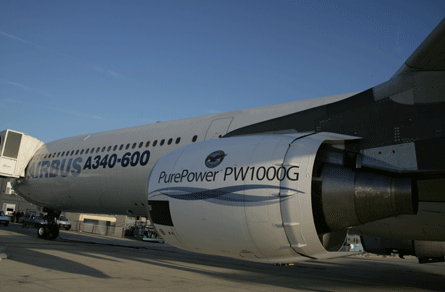Pratt & Whitney is shrugging off concerns about slow sales so far for the two new airliners that will be powered by its GTF geared turbofan after completing successful flight-evaluation programmes on its in-house Boeing 747 and Airbus's A340-600 test aircraft.
The GTF demonstrator engine performed well in 406h of ground- and flight-testing in the USA and Europe, says Bob Saia, P&W vice-president next-generation product family. "Once we configured it with a flight nacelle in our Florida facility, the engine did not see a wrench from there through to the end of the A340 programme."
He says that the engine was run at maximum power from the start of the trials and in every individual test, meaning that overall it was at this setting for 15% of the total test-time. "During the course of all the testing, which included 2g manoeuvres, we basically saw no change in overall engine performance - there was zero engine deterioration."
He adds that data from the 747 tests measuring the pressure and temperature of the air passing the GTF fan confirmed that "we are right where we want to be from an overall efficiency perspective".
 |
|---|
© Pratt & Whitney |
While uncertainty surrounds Bombardier's CSeries small airliner and Mitsubishi's MRJ regional jet as they struggle to attract additional customers and get on to a firmer footing, Saia is quick to emphasise that P&W is fully committed to developing the production version of the GTF for these aircraft, dubbed the PW1000G. "We're confident the programmes are going to go. P&W has over 1,000 engineers doing engineering work on their requirements."
BREATHING SPACE
However, Saia concedes the start of the new engine's detail design has been pushed back by around six months to give the airframe programmes more breathing space to secure customers, which may influence the design of the aircraft. "We want to ensure we don't have to go back and do any redesign. So we decided to use up some of the margin we had, which still allows us to meet the timetable," Saia says.
The GTF promises "12-15%" improvements in fuel burn over current turbofans, as well as a 50% reduction in NOx emissions and an unprecedented reduction in noise levels some 20db below Chapter 4.
Unsurprisingly, all the airframers have been keeping a close eye on the P&W engine's development, and Airbus was so keen on the GTF that it made sure it got its hands on the demonstrator for its own evaluation. As a result, there has been some speculation - even by the airframer's own executives - that the engine could be part of any A320 "refresh" package that may be in the works. But Airbus has dismissed any likelihood of a near-term GTF-powered airliner development from Toulouse, saying it has "no plans to install the GTF on current products".
Saia plays down the prospects of the GTF being adopted for a mid-life update for the A320 or any other narrowbody, given the costs and the likely inability of any such "hybrid" to take maximum benefit from the technology.
"From an engine manufacturer's perspective it costs about $1 billion in investment to put an engine on an airframe from design and certification, certification at an airplane level and the maintenance support," says Saia. "So there are some key fundamentals that must be assessed before we spend that $1 billion.
"We would want to have an airplane that's going to be in production for 10-15 years, so one of the concerns we would have about any type of re-engining is: does the production time and the forecast volume of sales support the investment? And in most cases it would not."
Saia says for the GTF's full benefits to be achieved, the fan diameter would need to be larger than those of the incumbent engines on any given airframe, which could compromise the re-engined aircraft's performance if it cannot be accommodated. "You have to look at it from the airplane perspective and whether the engine would be optimum if you've got to limit the fan diameter to make it fit," he says.
So beyond the CSeries and MRJ, P&W's goal is to find its way on to narrowbody replacement aircraft from Airbus and Boeing at the end of the decade. With that in mind, and the threat of advanced powerplants from GE and R-R, Saia says P&W is already well on its way to defining an "advanced GTF" design that should deliver another 8-10% improvement in fuel burn. A full-scale demonstrator should take to the air in "late 2012-13", he adds.
The first assessments of the A340 flight-test data should be completed before the end of March, covering oil system, installation and performance, while the crucial noise results are expected to be ready in May. However, the data from the A340 trial will not be made public until the second half of the year as P&W has a gentleman's agreement with its partner not to release any of the findings until it has Airbus's say-so.
But data from the 747 tests indicates that P&W will deliver on its performance promises, and it must hope now that the confidence it has in its new technology gets the backing from the market in the form of orders for the two airframes that will the GTF will power.
Source: Flight International
















